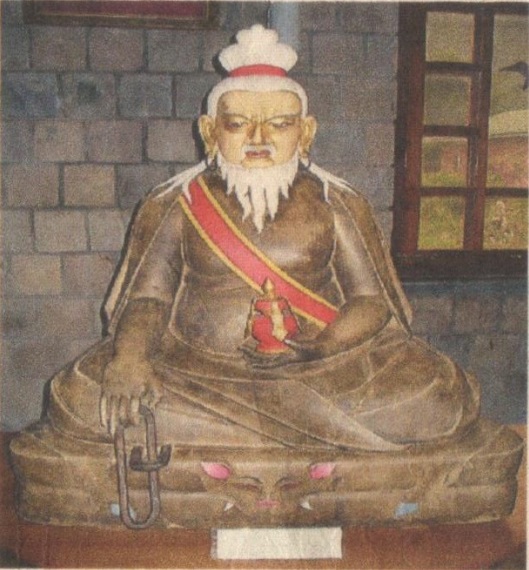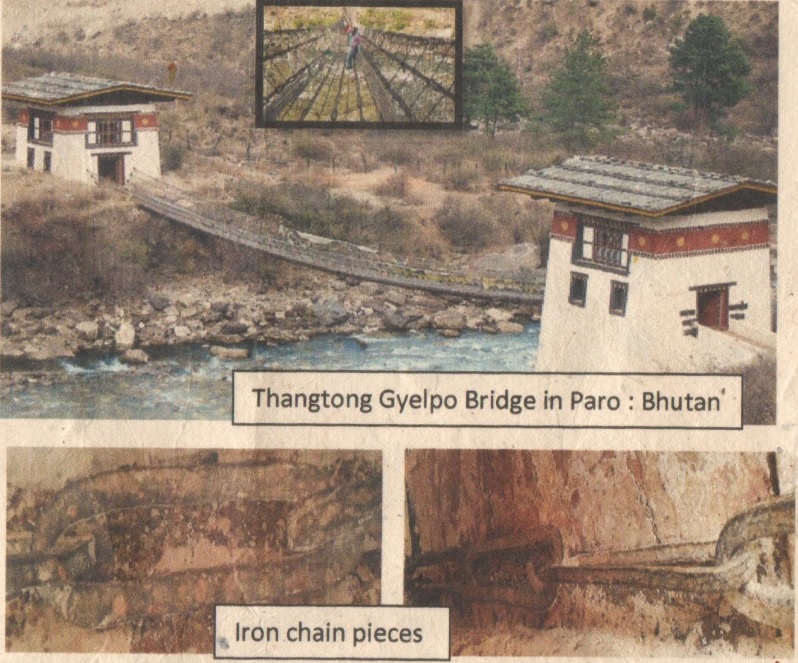|
|
|
|
|
|
|
Rings
|
|
|
|
| Thangtong Gyalpo Iron Ring (one piece) |
|
|
|
| ring |
|
Sku#:3117
|
|
|
|
|
|
|
 |
|
Please contact us to verify availability. 1-626-354-6228
Email: zambalallc@gmail.com
America area customers can view on this website first.
https://FlyingMystics.org/ |
|
|
|
|
|
|
Material: Celestial Iron, Meteorite Iron, Thangtong Gyalpo
Size: Ring Size (Currently only available in sizes 9, 10, and 11)
Description:
Thangtong Gyalpo (Tibetan: ཐང་སྟོང་རྒྱལ་པོ་, transliterated as Thangtong Gyalpo or Tangtong Gyalpo), also known as "Iron Bridge Venerable" or "King of the Vast Plains," is a legendary mahasiddha in Tibetan Buddhism. He was born in 1361 (some say 1385) and passed away in 1485 (or 1464) at the age of over 120. He is revered as a combined manifestation of Avalokitesvara and Hayagriva, and holds the lineage of both the Nyingma and Kagyu traditions (particularly the Upper Kagyu). He was not only a distinguished monk but also a versatile engineer, physician, poet, artist, and social reformer. Throughout his life, he traveled extensively throughout Tibet, China, India, Bhutan, and beyond, benefiting countless sentient beings.
A Brief Biography of Tangtong Gyalpo
From a young age, Tangtong Gyalpo displayed immense compassion and vowed to dedicate his life to benefiting all sentient beings. He traveled between the Pure Land and the Saṃsāra realms numerous times, receiving direct visions of the Buddha, Padmasambhava, Avalokitesvara, and Tara through meditation, and receiving guidance from these beings, which enabled him to construct countless statues, stupas, and books. He also invented Tibetan opera (Aché Lhamo) to raise funds for public facilities and spread the Dharma. He is said to have built 108 iron chain suspension bridges (some say 58), 60 wooden bridges, 118 ferries, 111 pagodas, and countless temples. These projects not only addressed the dangers of crossing the turbulent rivers of Tibet but also symbolized the profound Buddhist concept of bridges transporting people out of the cycle of suffering. Among the most famous are the remains of the Iron Bridge in Bhutan and the Luding Bridge in Kham, Sichuan, China, which is said to have been built with his iron chains.
In Tibet, he was known as the "Longevity King of the Snowy Land," renowned for his longevity and medical skills. During a plague, he personally prepared red and white pills, curing countless patients. His legendary deeds are filled with miraculous feats, such as entering temples on horseback, eating carrion as delicacies, and foreseeing the future. These "crazy" behaviors were seen as manifestations intended to enhance his own enlightenment and benefit sentient beings. He is also believed to be the reincarnation of Dolpopa Sherab Gyaltsen, a master of the Chonan school, and a descendant of the legendary heroic king Gesar.
The Origin and Story of the Sky Iron Ring
The "Sky Iron Ring" (also known as the "Thangtong Gyalpo Iron Ring" or "Iron Bridge Ring") originates from the iron chain suspension bridges built by Thangtong Gyalpo. These bridges were connected by special, sturdy iron chains that remained unshaken for centuries. In Buddhist tradition, iron chains are not only a marvel of engineering but also symbolize the wisdom and compassion of "indestructible, liberating all beings from suffering." Bridges, like the bodhisattva's path, help sentient beings cross the river of life and death.
The ring's origins can be traced back to events in Bhutan in the late 20th and early 21st centuries. Several iron bridges built by Thangtong Gyalpo (such as the Iron Chain Bridge in Paro Valley) fell into disrepair and were dismantled or decommissioned. Disciples of Dilgo Khyentse Rinpoche, with reverent hearts, removed the iron chain links from these bridges and forged them into rings for practitioners to wear. This act was considered a special opportunity to continue the master's blessings, allowing future generations to connect with Thangtong Gyalpo's merit field through these objects. These rings are made 100% of the original bridge iron and typically feature a simple, unadorned design, devoid of elaborate carving, reflecting the simplicity and power of the "Iron Bridge Master."
Anecdotally, the iron chain originates from the Chakzam lineage (Shangpa Kagyu lineage) of Tangtong Gyalpo. Legend has it that he received teachings from a vision of the wisdom dakini Niguma, emphasizing that the iron chain, like the vows of Vajradhara, is indestructible. Another legend states that Tangtong Gyalpo used the iron chain to subdue local evil spirits and clear a path, symbolizing the subjugation of inner demons. Wearers often consider the ring a "protective token," said to invoke the protection of a master, especially during travel, river crossings, or when facing obstacles.
Benefits and Merits of Wearing a Sky Iron Ring
In Tibetan Buddhism, wearing a sky iron ring is considered a sacred and blessed object. Its benefits and merits stem from Tangtong Gyalpo's immense vows and the meritorious nature of the iron bridge. While individual experiences vary, the following benefits are traditionally believed (based on Buddhist teachings and practitioners, not scientifically verified):
1. **Increased Lifespan and Health**: Tangtong Gyalpo was revered as the "King of Longevity," and the ring carries his blessings for medicine and longevity. The wearer is said to be free from illness and prolong life, especially against chronic illnesses and epidemics. Legend has it that he cured the plague with pills, and the iron chain resembles a "Longevity Bridge," helping people cross the river of longevity.
2. **Obstacle Removal and Safety Protection**: The iron chain symbolizes a solid shield, defusing travel, accidents, and external obstacles. Many practitioners report that wearing it helps them travel smoothly and avoid danger. This stems from the master's compassionate wish to build the bridge—"Without the bridge, all beings drown." The ring acts as a miniature bridge, protecting one's safety.
3. **Increased Merit and Accumulation of Merit**: Wearing the ring is like being near the Iron Bridge, a field of merit, accumulating immeasurable merit. It is said that touching or visualizing the ring daily is equivalent to making an offering to the master, increasing bodhicitta and the merit of generosity. According to Buddhist texts, building a bridge to help people cross the river is more meritorious than making statues or writing sutras, thus allowing the wearer to indirectly participate in this great cause.
4. **Spiritual Blessings and Enlightenment Aid**: As a ritual implement of Thangtong Gyalpo, it can invoke the master's wisdom and dakini blessings, helping practitioners to subdue greed, hatred, and delusion and enhance their meditation. Many masters (such as Dzogchen Ponlop Rinpoche) recommend using it in conjunction with Thangtong Gyalpo's Refuge Prayer to foster firm faith in the face of adversity.
5. **Auspiciousness for Family and Career**: Traditionally, Tibetans hang their thangkas for blessings during celebrations. Wearing the ring is believed to bring family harmony and career success, symbolizing the "iron chain connecting all beings."
In short, the Tiantie ring is not only a historical relic but also a living medium of blessings. It is recommended to wear it with reverence (such as on the right ring finger or as a necklace) and visualize Tangtong Gyalpo (e.g., an old man holding an iron chain, with a white beard) to amplify its benefits. To obtain it, one can seek out authentic Buddhist instrument suppliers, but most importantly, one must cultivate a heart of altruism to truly experience its virtue.
This description is based on Tibetan Buddhist biographies and historical records. If you require specific transmission, it is recommended to consult a qualified teacher.
.jpg)


Emanation of Avalokitesavara, the Buddha of compassion and of Padmasmbhava , the disciple of Buddha who brought Buddhism to Tebet.
Thangtong Gyalpo was incarnation of the illustrious Dolpopa Sherab Gyaltsen (1292-1361), a leading Jonangpa master and formulator of the shentong view of emptiness. He is said to have built 58 iron chain suspension bridges around Tibet and Bhutan, several of which are still in use today.
Thangtong Gyalpo was born at Olpa Lhartse in upper Tsang in 1361, Ge us well known for his founding of Ache Lhamo. The Tibetan opera, and the numerous iron suspension bridges he built to ease travel and pilgrimage though the Himalayas border. Lron chain suspension bridges, about 65km from Lhasa, at Tsangpo, still existed in 1948.
After arriving in Bhutan in 1433 he built 8 iron bridges in different parts of the country. One of the bridge he erected a bridge across the Paro Chhu to Tachog. The successors of the first Chakzampa built a Lhakhang(temple) here. In 1969, the iron suspension bridge was destroyed by high water. The chains were partly rescued and kept in the attic of the shed behind the Lhakang. To ensure the access to the Tachong Lhakhang across the swift moving Paro Chhu. As per the royal wish of His Majesty King Jigme Singye Wangchuck in 2005 the cable rope suspension bridge again substituted with an iron chain bridge. |
|
|
 |
|
|
|